This week, why some people have green blood, how radiation-hungry fungi will feed astronauts of the future, and how a cider a day keeps the doctor at bay. We discuss corrupt chemists, what happens when galaxies collide, how Beaujolais benefits your breath and if a person can feel the cold in space. Plus, in Kitchen Science we iron out the crumbs in your cornflakes!
In this episode
Green blooded male...
A Canadian man undergoing surgery surprised doctors recently when they opened him up to find that he had green blood!
A report published by Alana Flexman from the University of British Columbia describes how the man, a 42 year old smoker, was due to undergo emergency surgery to relieve a condition called "compartment syndrome", which had been brought on when he fell asleep in a sitting position for several hours. This had triggered swelling and subsequent vascular problems in his legs, which the surgeons were seeking to relieve by cutting through some of the tough connective tissue, called fascia, which surrounds the muscles in the legs. But when the man was taken to the operating theatre and a tube was inserted into an artery to remove a blood sample, the anaesthetist was surprised to see green blood coming out.
It turned out that the man was suffering from a condition called sulphaemoglobinaemia, which is when sulphur groups become chemically bonded to haemoglobin, the iron-containing protein found in red blood cells that carry oxygen around the body. The patient had been using large amounts of an anti-migraine drug called sumatriptan, which contains sulphur compounds called sulphonamides. The doctors think that this had become linked to his haemoglobin, causing it to change colour. This is probably correct because after he stopped taking the drug the levels of sulphaemoglobin fell and five weeks later his blood was red again!
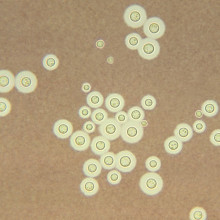
03:58 - Radiation-hungry fungi feed astronauts
Radiation-hungry fungi feed astronauts
Inspired by findings from Chernobyl, biologists have discovered that some fungi can grow using radiation instead of light, this may make them ideal for growing in space for astronaut food.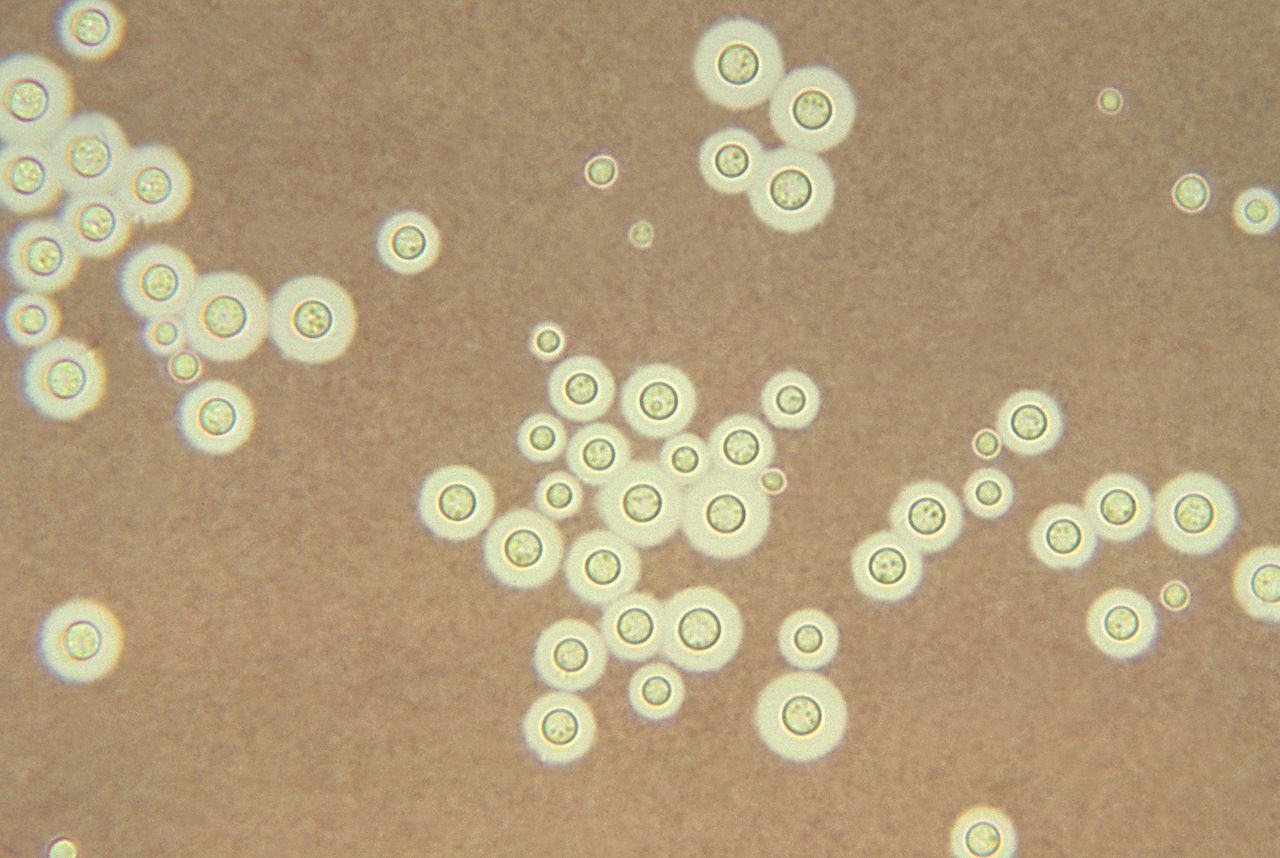
The work began after a robot explorer was sent into the still highly radioactive Chernobyl site and emerged with samples of black fungi found growing on the walls. It was realised that the black colour of the fungi was caused by the chemical melanin, the same chemical that pigments your skin and makes people go brown in the sun.
Dr. Arturo Casadevall wondered if the radiation was actually feeding the fungi so set up a number of experiments to test his theory. He found that just like chlorophyll captured ordinary light to convert to energy in plants the melanin could capture high energy radiation to feed the fungi. It was also found that species of fungi grown in his lab grew much faster when exposed to increased radiation.
Dr. Casadevall is also testing edible fungi which may provide excellent food to be grown in the harsh radiation conditions in space. The results may also have implications for the possibilities of life on other worlds such as Mars where conditions are much worse than the Earth.
Leopards lured by mobile ringtones
Forest guards in western India are using mobile ringtones to protect locals by luring leopards lurking near human settlements into traps. Leopards in the state of Gujarat occasionally wander into human habitations looking for food and this can lead to people being attacked and injured. In the past rangers have resorted to tyinggoats to trees to attract the cats, which then fall into concealed pits. But this can be dangerous and also takes time. So instead they're taking a different tack, downloading ringtones of cows mooing and goats bleating. These are played for several hours at a time out of speakers hidden behind a cage. The leopards invariably turn up looking for a ready meal and are safely caught and later released back into forest areas. "The moos of a cow and bleating of a goat has proved effective to trap leopards," said oneGujarat forest official. "This trick works". Wildlife groups have also welcomed the initiative since it's less likely to result in the captured animal becoming injured.
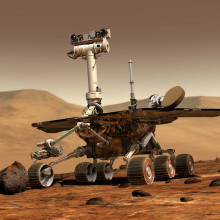
09:24 - Puddles of water found on Mars by NASA
Puddles of water found on Mars by NASA
An image processing engineer at Lockheed Martin has just announced that he believes one of NASA's Martian rovers has discovered puddles of water on the surface of the red planet.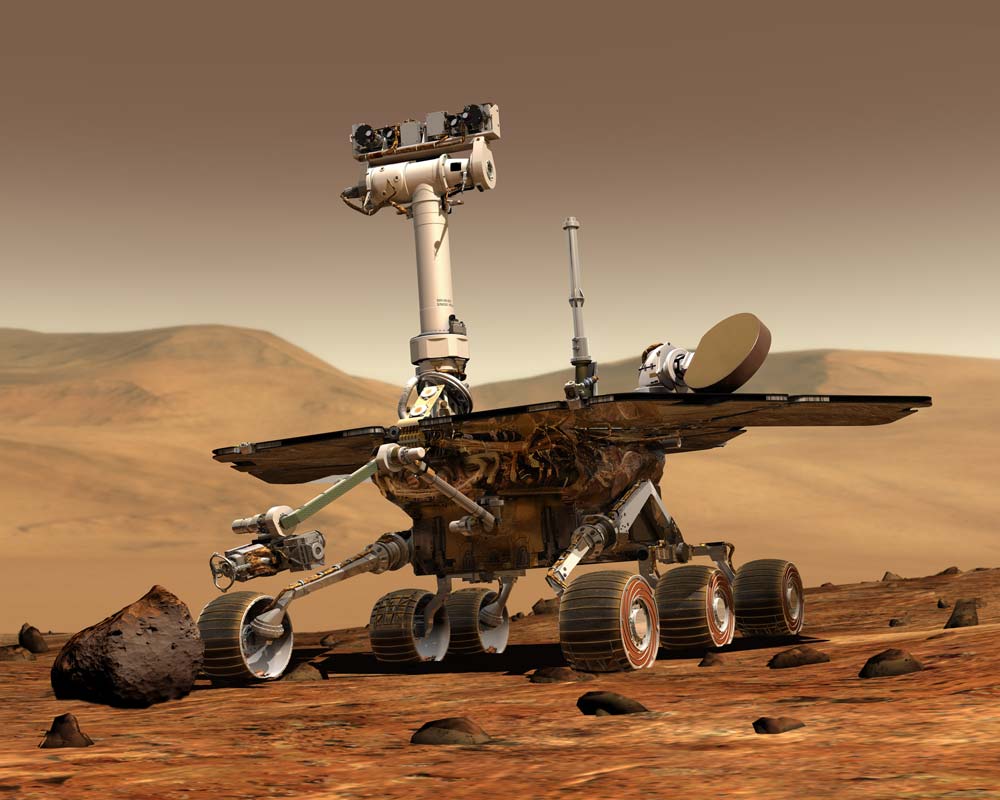
Scientists currently believe that Mars is a cold, frigid dessert with very little atmosphere. We do know that there is water ice below the surface in a sort of permafrost, but because the air pressure is so low any water at the surface would just evaporate away.
Ron Levin has been examining photos taken by the Rover Opportunity and has found some intriguing looking images taken about two years ago. What he's found is a series of very smooth, bluish features sat in the bottom of depressions at the bottom of a crater that the rover was exploring. This is perhaps just what you'd expect if they were puddles of water. Levin even claims that you can see small stones below the surface and poking through the water.
Not all scientists are convinced, however. We can recreate the surface conditions at Mars is specially controlled chambers in laboratories on Earth and it seems that it would need some very special weather on Mars to allow water to exist, such as absolutely no winds and summertime temperatures. Another explanation could be that this is actually ice that has frozen in smooth pools on the surface.
Unfortunately it seems we'll probably never find out. The NASA rovers were only supposed to survive 3 months on Mars, but have so far lasted 3 years. Because the images were taken 2 years ago the rover has moved on it's unlikely that it will be possible to send the rover back to have another better look.
If we can get liquid water on Mars then it's a boost for those who believe life might exist on the planet and perhaps the next European Mars mission called Mars express scheduled to launch in 2013 might provide some more answers.
Hey presto, embryonic stem cells but without the embryos
Two groups of scientists have independently stumbled on a way to create tailor-made embryonic stem cells (ES cells), but without the aid of an embryo. The discovery, made by MIT's Rudolf Jaenisch in Boston US, and Shiya Yamanaka from Kyoto University in Japan, may hold the key to producing genetically compatible embryonic stem cells for an individual "on demand", so they can be used to repair damaged tissues and organs.
When a cell becomes specialised to perform a certain task, a process known as differentiation, it loses the ability to carry out other roles or turn into other cell types. This seems to be associated with a switch in the pattern of genes that are turned on in the cell. The key is therefore to find a way to re-programme a cell into thinking it's in an embryo again, so that it begins to behave like a stem cell once more. To do this the teams started with mature skin cells, known as a fibroblasts, and used viruses to deliver four essential "stem cell master genes" known as Sox-2, c-Myc, Oct4 and Klf4. The results were cells indistinguishable from ES cells. And when the researchers replaced all of the cells of an early animal embryo with the new ES cells they could produce a new animal, proving that they were capable of giving rise to the full range of mature adult tissues. "This means that we could produce cells specific for an individual that could be used for repair without the risk of rejection," points out Jaenisch.
However, the teams still have to prove that the technique will work with human cells, and as Yamanaka points out "the safety of this approach is, at the moment, questionable. We have used retroviruses to introduce the four factors [genes], which could trigger tumours, and one of those factors is a well-known oncogene [a gene that triggers cancer]". Despite this it's still a massive leap forward and re-programming adult cells to return to an embryonic stem cell like state has huge clinical implications.
Why does my voice sound different on a tape recorder/microphone?
There's nothing worse than hearing a recording of your voice for the first time! The reason is that how we think we sound isn't really how we sound.Inside your ears there is an organ called a cochlea, a special neurological structure that converts the vibrations of sounds in the air into electrical signals that the brain can understand. It gets stimulated by the pressure waves caused by sounds in the air, but at the same time can pick up the vibration of the bones in your skull. When you are listening to sounds in the environment, the chief source of those sounds is coming through the air, very little comes through the bone. When you're speaking, however, your whole head resonates; it vibrates. This means that your cochlea gets stimulated by your skull vibrating, as well as the sound coming out of your mouth and going through the air to your ears.The body does two things; it gets a different version of those vibrations (through the bone and the ear), but it also has a protective mechanism to cut down the amount of sound which is going into the cochlea. It reduces sensitivity of your ear a little when you're speaking, so you get a slightly different rendition of what your voice sounds like.That's why, when you hear yourself recorded and played back, you sound totally different, because all you hear back from the tape recorder is sound coming through the air, minus the skull vibration and bone conduction.
How fast do you have to go to leave the solar system?
There's no special technology involved, it's basically the same as when you launch a rocket off the surface of the Earth; you have to go fast enough to escape the Earth's gravity. If you were standing on the surface of the sun (and could cope with the 5000 degree temperature) and launched a rocket, you would have to get it up to 617.5 kilometres per second (km/s) to get it to escape the gravitational attraction of the sun and out of the solar system.As the Earth is already travelling at 30 km/s you don't need to get it quite as fast, but you couldn't possibly launch something at those sorts of speeds. To get out to the far reaches of the solar system, and beyond, you need to get a boost by whizzing past another planet. This is called 'gravity assisted' because you use the gravity of a planet to sling shot you further out into the solar system.
What would happen if another galaxy collided with our own?
Well, actually yes. Stars are at relatively low density in a galaxy, and so if two galaxies collide, the probability is that actually not one single star would collide in the process.There is, however, a lot of gas between the stars in a galaxy, and this gas would collide and be compressed, and that would, in itself, form a whole new generation of stars. The gravity from these stars would affect everything around them, and you would end up with a great big mess. Here on Earth, in the outer spiral arm of the Milky Way, we would probably survive.David Block, of the University of the Witwatersrand, South Africa, observed the Andromeda galaxy and a nearby dwarf galaxy and noticed a ripple effect in Andromeda. He worked out that if you wind back the clock on these ripples, it puts the origin at about 200 million years ago. The ripples are thought to be the result of Andromeda having previously collided with one of it's companion galaxies, so galaxies can definitely survive such a collision, but it's anybody's guess what the results of this ripple effect would be.Galaxies are not necessarily all moving in the same direction, some, found in clusters of galaxies, orbit each other. In all, it's a bit of a mess! This means that galaxy collisions do happen.We do know that the Andromeda galaxy is going to collide with our own. In about 3 billion years, even before our sun has died, Andromeda will collide with the Milky Way. Maybe future generations of humans, or whatever is living on Earth in 3 billion years, will be able to observe what does happen when two galaxies collide!
23:57 - A Scrumpy a day keeps the Doctor away?
A Scrumpy a day keeps the Doctor away?
with Serena Marks, University of Glasgow
Chris - You've been doing some interesting work on cider, tell us about that...
Serena - Last year, I was analysing cider apples and looking for different levels of antioxidants, and this year we've released some data about ciders showing that some of them also have high levels of antioxidants.
Chris - So just tell us what an antioxidant is, what they do and why we need them.
Serena - Antioxidants are thought to quench free radicals in the body, so these are the really reactive compounds that can do damage within the body, it's believed that these (antioxidants) might help against certain diseases, for example cancer and heart disease.
Chris - So the more you can pack into your body, the better?
Serena - That's the theory, yes.
Chris - So what's the bottom line with respect to making cider, and should we therefore be drinking cider instead of eating apples?
Serena - The previous work showed that cider apples contain more antioxidants than normal dessert apples, and we've gone on to look at the ciders and found that ciders made from cider apples that contain lots of antioxidants actually have higher levels than those made from other apples.
Chris - Why is that?
Serena - I think it's just that the more antioxidants you have in the first place, then more are likely to make it through the cider making process and into the final product. We found that some apple juices contain lower levels of antioxidants than some of the ciders, and that's again because apple juices are made from dessert apples, which contain lower levels of these compounds.
Chris - We had Roger Corder from Barts & the London medical school in London on the show earlier this year. He's been looking at antioxidants in red wine, and the interesting thing he said was that you can't just drink the juice, you need the alcohol. The health-giving compounds, the antioxidants and procyanadin, dissolve in the alcohol, so if you don't have the alcohol you don't get as much of the goodies as you would get from just grapes and pips.
Serena - Last year I did a feeding study looking at putting people on a low phenolic diet for 36 hours, then getting them to drink a pint of cider and then taking blood and urine. Hopefully from our data we will be able to understand if you drink a pint of cider how many of these phenolics are absorbed, and we can compare this with data where they used apple juice to see if there's a difference. Procyanadins are actually found in cider and cider apples as well; in fact cider apples contain very high levels of these, so cider might be a good source of procyanadins.
Chris - Is a pint of cider a day consistent with good health in other respects? That could be quite a lot of alcohol, especially if you drink good scrumpy.
Serena - If you're talking about a 4% cider that's about 2 units [of alcohol], maybe only half a pint of cider might be enough. We're still trying to work out how much of these phenolics are absorbed while you drink. Our test subjects were drinking 500 ml to get an idea of how much you would have to drink to get these phenolics into your body.
Chris - I have to ask Serena, just to finish, who actually sponsored the study?
Serena - Okay, the study is actually sponsored by the National Association of Cider Makers.
Chris - Do you think that might have had an impact on the results?
Serena - No, it didn't! [Laughs]
Chris - So the bottom line is that you're waiting to see if apple juice is as good as cider, but you get lots of antioxidants from cider, so if you had a choice between beer and cider, it should be cider.
Serena - Oh definitely cider. Cider contains much more antioxidants than beer.
Do rainbows follow the contours of the horizon?
It's actually neither. A rainbow is caused by sunlight hitting clouds or rain, and can usually only be seen if there is a background of dark clouds.Sunbeams go into a raindrop, reflect off the back inside surface of the raindrop and come back out of the front. When they come back out, the raindrop behaves like a prism, and splits the light into all the different wavelengths that make up white light. White light, such as light from the Sun, consists of lots of different colours of light added together, so when they are all together it looks white, but if you split them up you can see the colours.A double rainbow occurs when the light does a double journey; it reflects off the back of the raindrop, then bounces off the front inside surface, back to the back surface and then out. This causes a second rainbow outside the first one, but with the colours the other way around.The curvature of a rainbow different. If you could look at a rainbow from far enough away, you would see a complete circle. This is caused by the angle at which light exits a (roughly spherical) raindrop. We can't see the entire circle because the Earth gets in the way.You do get some similar effects from the moon. When you get very high altitude clouds consisting of many ice particles, you can often get a similar effect to a rainbow. It's less common and less bright than a rainbow though.
How do we get a rainbow effect from a CD?
The reason a rainbow effect is created on oil is because of interference. Oil on a puddle will tend to create a thin film, which can be anything from 10 to 100 molecules thick, so it's very thin. Each of them can act like a tiny mirror, so when light hits the surface of an oily puddle, some will reflect off the water under the oil, and some will reflect off the oil layers.As light is a wave, if you cause the waves to stop lining up with each other, you can get the 'up' part of one wave aligning with the 'down' part of another wave, and these can cancel out. This is called interference, and it causes a pattern of colours according to how much interference is occurring. Oil films of different thicknesses cause different amounts of interference, so you get a rainbow effect.The same effect is seen on the surface of a bubble, which is also a thin oily film with varying thicknesses.
33:29 - Science Update - Lifestyles and Obesity
Science Update - Lifestyles and Obesity
with Chelsea Wald and Bob Hirshon
Bob - This week for the Naked Scientists, we're going to tell you some of the things scientists are learning about what contributes to obesity. I'm going to talk about kids, TV and junk food, but first Chelsea's here to tell us what love and marriage have to do with it.
Chelsea - Couples who shack up risk seeing their weight ratchet up. That's according to epidemiologist Penny Gordon-Larsen and student Natalie The of the University of North Carolina at Chapel Hill. They found that couples who are married or just living together are more likely to have one or both partners be obese than couples who are just dating. The says there may be something about living together that promotes obesity; like more time demands, or more food around. Or people might just pick partners who share their tendencies.
Natalie The (University of North Carolina-Chapel Hill) - So maybe if I'm sedentary, I also like spending time with someone who wants to watch TV or watch movies as opposed to someone who wants to go out and run.
Chelsea - Whatever the reason, the finding suggests that people who want to make lifestyle changes would do well to convince their partners to join them.
Bob - Thanks, Chelsea. On average, kids eat nearly twice as much after seeing junk food ads on TV, than they do after watching ads for non-food items. That's the result of a new study at the University of Liverpool. Psychologist Jason Halford says the effect was strongest in overweight and obese children. Those kids not only increased their eating by higher percentages, but also gravitated more toward high-fat snacks after watching the food commercials.
Jason Halford (University of Liverpool) - And those brands were not advertised. Although the adverts were for branded foods, the foods we served them were not linked to the brand in any way. So it was a beyond-brand effect, if you see what I mean.
Bob - Halford notes that TV watching is directly related to childhood weight gain, and suggests the barrage of food ads may be partly responsible.
Chelsea - Thanks, Bob. Next time, we'll talk about some cool, self-planting seeds. Until then, I'm Chelsea Wald...
Bob - and I'm Bob Hirshon, for AAAS, The Science Society. Back to you, Naked Scientists!
35:35 - Corruption in China, the Atkins diet and the goodness of wine.
Corruption in China, the Atkins diet and the goodness of wine.
with Mark Peplow, Chemistry World Magazine
Chris - Now Mark Peplow the editor of Chemistry World magazine from the Royal Society of Chemistry is here. What have you got for us Mark?
Mark: The first story up is a bit gruesome but absolutely fascinating. It's about the former head of China's State Food and Drug Agency, just a few weeks ago he was sentenced to death after being found guilty of bribery and corruption. This is such a big deal because estimate of the number of people who die in China every year just by taking counterfeit or sub-standard drugs runs in the hundreds of thousands. This guy Zheng Xiaoyu was in charge of the state drug agency for about 8 years and he's been found guilty of taking bribes of up to a million dollars from 8 different pharmaceutical companies and illegally approving their products.
Chris: It's quite interesting, because most people don't view China as being the most open country in the world when it comes to giving information and human rights, so it seems strange that they are taking such a though stance on this guy. Is it because it directly affects people in China that they've done this?
Mark: It's much broader than that actually, one of the interesting things about the way China's business, industry and science is going at the moment is that there is this huge push to get into the global market place and also to attract investment from abroad into China. This move to execute Zheng is generally seen as a way to send out a real 'getting though' message to the rest of the world, that the Chinese government are trying to clean-up the amount of bribery and corruption which really spreads throughout the whole state system but has particularly effected the pharmaceutical industry. It's very telling that on the day that his execution was announced there was no official comment from the Chinese drug agency but they did post the second draft of their revised regulations on how they were going to clean-up their industry.
Chris: Still a pretty radical thing to just execute someone, I mean we've got people in prison here for doing probably more corruptive things than that, I would think?
Mark: Absolutely and as many commentators have pointed out, this may actually be a counter-productive move. Clearly Zheng isn't the only person guilty of corruption within the drug agency. In fact, there is a great deal of evidence that it's really the negligence of local officials which is the problem here. I think this is likely to send out a mixed message to pharmaceutical companies who want to invest in China. It shows that the rule of law is somewhat patchy, it also shows that it's extremely open to political motivation as well; there's been a massive smear campaign against this guy, before he was found guilty, running in Chinese state media for the last 6 months.
Chris: Well that's certainly food for thought, and talking of food, Atkins; it made the guy who wrote the book an absolute fortune, unfortunately he is no longer here to enjoy that fortune, but people have now found some scientific credence for his argument that eating a high fat diet makes you lose weight.
Mark: That's right. The Atkins diet is basically very high in fat and very low in carbohydrates. It's called a ketogenic diet because it makes your body breakdown fatty acids into a variety of compounds broadly classed as ketones, so breaking down these fatty acids, in theory, should help you slim down. Now there are two studies that were published last week in the Journal of Cell Metabolism. The first found that this sort of ketogenic diet stimulates the production of a hormone called fibroblast growth factor 21. The second study found that this growth factor actually stimulates fat metabolism in the liver. In this study that was done in Texas, they injected mice with this growth factor and found that it turned on a starvation response, so the mice switch from using carbohydrates to burning up their fat stores as an energy supply.
Chris: So is this the diet pill of the future then? Is this the remedy that people have been searching for?
Mark: Well, there is no way of telling, because this may be the hormone that's responsible for turning your body to burning its fat supplies. But at this stage the experiments have been done in mice so there is no telling what else it's doing to your body.
Chris: Hmm... that's worrying. But talking of putting things in your body that might actually do good things, to end on a high note, we've all heard of cider, now you've got some good news about red wine?
Mark: Yes, this is a nice, fun story for any wine lover really, a team of scientists at the university of Pavia in Italy have been investigating what happens to wine when you slosh it around your mouth. It tastes good for a start, but they've found that both red and white wine can actually kill the bacteria that causes caries, otherwise known as tooth decay.
Chris: But isn't that just the alcohol?
Mark: Well, that's the interesting thing, you might think that, but they actually checked this by de-alcoholising their wines prior to the test in order to exclude the effect of alcohol on bacterial growth. They also checked to make sure that it wasn't the acidity of the wine by making some synthetic wine with the same pH (acidity) and it was nothing like the effect of the real wine. But they think that they have pinned down the effect to a group of acids called succinic acid, malic acid, tartaric acid that are present in wines, particularly prevalent in red wines. They think that these acids can inhibit the activity of enzymes, which are big molocules that spped up chemical reactions in cells. Effectively that kills off bacteria, more than 99.9% of all the bacteria in your mouth in one particular case.
Chris: How much better or worse is this than just toothpaste?
Mark: Clearly this isn't the only way that you can kill bacteria in your mouth and there are a variety of mouth washes out there, but if you are looking for another excuse to have just that extra glass of wine, make sure you slosh it around your mouth good and proper!
Chris: The only slight problem is that these red wines have a lot of tannin so you end up with nice, carie-free teeth but it doesn't stop them from going black, at least in the short term?
Mark: That's possibly true but as in all things, moderation is the key I think.
Chris: Thanks Mark. That's Mark Peplow the editor of Chemistry World magazine from the Royal Society of Chemistry, and you can find out more about Mark and what he writes about in his work at chemistryworld.org.
How do you get ice needles in puddles?
This is likely to be caused by water condensing out of the atmosphere onto a point. Once there is a nucleation centre, such as an ice crystal in the mud on which more ice can form. This small crystal of ice would not only offer a nucleation point, but would also separate the condensed water vapour from the relatively warm Earth, encouraging freezing on this, slightly higher, point. This would lead to a 'stalagmite' of ice forming from atmospheric water vapour.
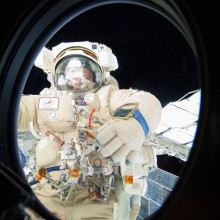
Would space feel cold?
The answer is both!
The background temperature is colder in space than on Earth because we have an atmosphere, which keeps us warm. So at the distance the Earth is from the Sun, it's about -50 degrees Celsius in space.
On Earth, we lose heat through radiation, evaporation of sweat, and by conduction of heat to the air. It is harder to lose heat in space as you can only lose heat through radiation. This is where electrons in the molecules in our body go from a high energy state to a lower energy state, losing energy when they do so by radiating infra-red (heat) radiation.
Conversely, when you face the Sun, you will absorb the Sun's radiation and be warm. But, at the same time, your back will be in shade and will lose heat rapidly by radiation as there's no atmosphere to keep you warm.
In other words, large temperature gradients are found in space, so things get very hot when they are in the Sun's rays, but very cold when they are in shade, so the answer to the question is space feels both cold and warm!
What would happen if our galaxy got sucked into a black hole?
Black holes are a lot smaller than the milky way, which actually has what's called a Supermassive black hole in it's centre. Each galaxy seems to have a black hole in the middle of it, around which the stars in the galaxy orbit. As far as we know, there is no 'other side' to a black hole, and if we were to go into one, we would undergo a process known as spaghettification, where the gravity of the black hole pulls matter into long thin shapes, rather like spaghetti.
Is global warming all made by humans?
[We put this question to Jonathan Shanklin, who discovered the hole in the ozone layer and was our guest on the Atmospheric Analysis show]The Earth does go through regular cycles of warm and cold, and we are currently in one of the warm periods. The cycles are clearly shown in Antarctic ice cores, which show several cycles over the last 750,000 years, each one lasting around 120,000 years. Carbon dioxide levels and methane levels are high during the warm periods and low during the cold periods. The main driver behind these changes are variations in the Earth's orbit, and these would suggest that we should now be heading towards a very slow cooling.We have however changed our atmosphere so fundamentally that carbon dioxide levels are much higher than at any time in the last 750,000 years. This much higher level of carbon dioxide (30%) is what is giving rise to the anthropogenic global warming. We are probably committed to at least a 5 degree rise in average global temperature. This will have dramatic effects on ice cover and sea level. The need to cut carbon dioxide levels so urgently is to prevent things getting even worse. The problem is actually even greater than this, as in the developed world we are consumming the resources of over three planets. This is not sustainable as we only have one planet!
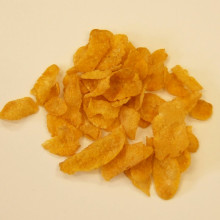









Comments
Add a comment